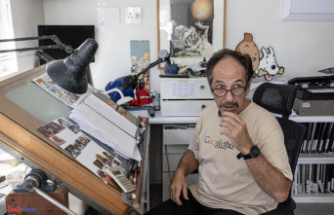The world of science has celebrated this Saturday two great news, received both as two Christmas gifts in full recruceration of the Covid pandemic by the OMICRON variant. On the island of La Palma, volcanic eruption was officially given that for three months sowed destruction and despair among its inhabitants. Minutes before that ad, 4,500 kilometers away, an imposing Rocket Ariane 5 put in orbit in the French Guiana the largest and most powerful space telescope built by humanity, James Webb.
"It's a fantastic day for Earth," said Bill Nelson, director of NASA. "It's a true Christmas gift," he added from the Space Port of Kurú Thomas Zurbuchen, responsible for the scientific missions of the US agency. «This launch celebrates, spectacularly, the international collaboration that has made this avant-garde mission possible ... we are closer to obtain the new vision of the universe of James Webb, and of the impressive scientific discoveries that I will bring," he said for his part Josef Aschbacher, General Director of the European Space Agency (ESA).
It is, in effect, of a joint mission of NASA, the ESA and the Canadian Space Agency designed to study the first galaxies and stars that were formed in the universe, about 13,500 million years ago, and to look for signs of life in Planets outside the solar system. Therefore, they compare it with "a time machine". An ambitious goal that has not been cheap: the development and construction of this sophisticated instrument has cost about 9.6 billion dollars (8,500 million euros). Well above the 500 million budgeted initially, in the mid-1990s. The deadlines and the telescope took off with about 14 years of delay with respect to the initial plan.
There is, therefore, a lot of tension and pressure because the mission is a success. And at the close of this edition, everything went as planned. Half an hour after the release, which took place at 13.20 (Spanish peninsular time), the applause flooded the control centers by completing the separation of the telescope and the rocket and deployed the solar panels that supply energy.
"They have been 30 minutes very stressful because the responsibility we have in the team of deployments and separation mechanisms is enormous," NASA Alejandro Rivera engineer told this newspaper, who has lived the launch at the NASA Control Center. In Baltimore (USA) from which the telescope is operated.
Despite the joy and relief of yesterday, the two weeks remaining ahead will be decisive: "From my point of view, the first 14 days, in which the main deployments and the corrections of course and trajectory are produced, they represent the phase More critical The reason is that if some of the deployments do not occur adequately, it could have very harmful effects for the scientific mission. It will be the 14 days of terror, "explains this engineer born in Gijón and nationalized American who experienced his most exciting day at the space agency since he started working there 21 years ago - the project of James Webb joined in 2013.
In those two weeks, the maneuvers required to start, among others, the two star components of the telescope: a thermal shield of the size of a tennis court that will protect the telescope of solar radiation and heat, and a large mirror 6.5 meters from gold coated diameter to better reflect light.
"At the end of the third month we can take the first images with scientific quality. Also at that time, James Webb will complete the initial orbit of it around point L2 from which he will work [1.5 million kilometers from Earth]. After another two months of calibrations, and at six months since the launch, it will begin its scientific mission, "summarizes this engineer.
The development of this great engineering work has also been wrapped in another controversy. Last March, a group of scientists requested NASA to change the name of the Observatory, considering that James Edwin Webb, second director of the agency, had undertaken homophobic policies during the time he worked at the space agency. NASA opened an investigation after which decided to keep the name in honor of which is considered one of the key characters in the Apolo Misiones to the Moon (led the agency between 1961 and 1968) and who died in 1992 at 85 years.
Date Of Update: 07 January 2022, 15:38











